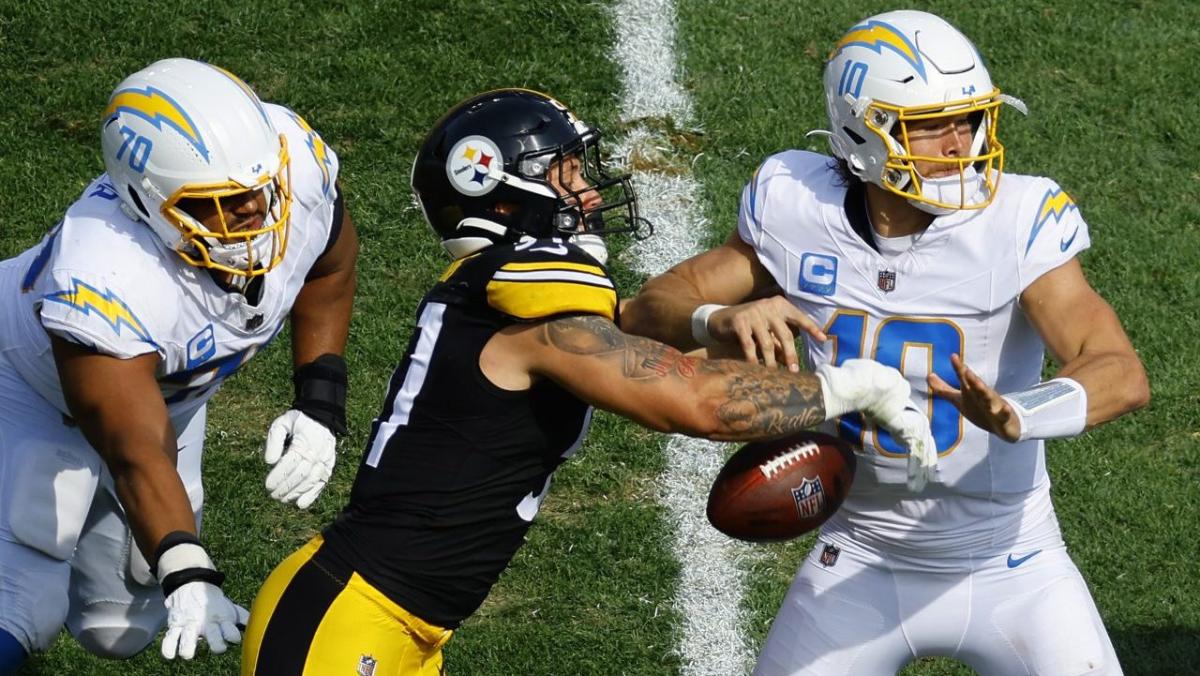Sports
NFL Offenses Sag, but QB Play Isn’t a Drag on TV Ratings

For the sake of argument, let’s say you go to sleep one night and wake up the next morning in 1977. It doesn’t take very long to figure out that you’ve tumbled through some kind of rift in the space-time continuum; for one thing, Gramma sure seems to be alive, and she’s knitting a sweater with Rocky Bleier’s face on it. The kids on the school bus are all twiddling away at their handheld Mattel Electronic Football games and the Health-Ed teacher spends much of the period before lunch inveighing against the dangers of Quaaludes. Folly is in the air, except for on the gridiron, where the NFL is grinding out a bone-bruising 287.8 rushing yards per game.
And then the alarm on your iPhone wakes you up, because time travel isn’t real. But as you hunker down in front of the Chargers-Steelers game, you find yourself thinking that you may have inadvertently brought some of the dream world back with you to 2024. This is 3-yards-and-a-cloud-of-dust, gutbucket football, and as you flip between the regional feeds it becomes apparent that the pass-happy offensive schemes that have ruled the NFL for the last two decades have fallen out of favor.
In their first three games under Jim Harbaugh, Justin Herbert and the Chargers have all but let the air out of the ball. LA is currently averaging just 125.7 aerial yards per game, which marks a whopping 59% decline compared to the year-ago 308.7. While caveats abound—Harbaugh is a fiend for the running game, and Herbert’s been gimpy since suffering a high-ankle sprain in Week 2—the whiplash change of tactics is still pretty remarkable. Last season at this time, the Chargers could lay claim to the NFL’s third most prolific passing attack, while this year’s Bolts are now at the opposite end of the spectrum at No. 31.
And it’s not just a Harbaugh/Herbert thing. At 201.2 passing yards per game, the league has amassed the least frequent flier miles since 2003 (200.4), as aerial gains are down 9% compared to the analogous stretch in 2023. Production, predictably enough, is also on the wane; the NFL average of 1.2 passing touchdowns per game is the lowest the metric’s been since 1993.
While at least one offensive coordinator has had to tear up the playbook in the wake of a catastrophic injury to his quarterback—Miami will have to go without the services of $212.4 million man Tua Tagovailoa through at least Oct. 20, following his latest concussion diagnosis—a number of healthy signal callers have seen their passing stats shrink in 2024. The ball is simply not traveling very far before it hits the receiver’s hands; thus far Patrick Mahomes has seen his average depth of throw shrink to 5.2 yards per toss, down a chunk from his year-ago 6.5 yards and off significantly from his bombs-away rookie campaign (9.1).
If Mahomes’ shorter trajectories are a function of his lack of deep threats (Tyreek Hill is long gone and Travis Kelce is about to blow out 35 birthday candles), the State Farm pitchman has had to increasingly rely on the short pass as defenses keep showing him two-high coverage. And while Mahomes’ quick release amounts to a death of 1,000 cuts for the 11 guys on the other side of the line of scrimmage, the dink-and-dunk approach has eaten into his overall gains; the defending Super Bowls champ are averaging 211.7 yards in the air versus the year-ago 275.7.
Other backsliders include the Patriots, which are now last in the league with just 102 passing yards per game, down from 235.7, and the Jaguars, which have been limited to 160.7 yards per game via the air, compared to 240.7 in the year-ago period.
Among the few QBs who’ve managed to buck the trend are Buffalo’s mad bomber Josh Allen and Dallas’ Dak Prescott. Unfortunately for the Cowboys and their legion of fans, Dak’s gaudy passing stats (he’s already amassed an NFL-best 851 yards) are a matter of necessity; because Dallas can’t run the ball—with a meager average of 73.7 ground yards per game, they’re the third-worst rushing attack in the NFL—he has no choice but to let it rip.
As much as the explosive growth of the passing game has coincided with the NFL’s massive gains in TV deliveries in recent years, this season’s early defensive clampdown hasn’t had a negative impact on the league’s ratings thus far. Through Monday night’s twin bill on ABC and ESPN, NFL games are averaging 18.6 million viewers per telecast, good for a nine-year high. If the splashy aerial antics are in short supply, fans have been compensated with an audience-friendly slate of September football—one that’s been powered by three straight Chiefs appearances.
Season-to-date, Mahomes & Co. have served up 27.4 million impressions per outing; by way of comparison, the average primetime entertainment series in 2023-24 eked out 3.38 million viewers per episode.
Until offensive coordinators figure out a way to counter Cover 2, fans may want to dial back their appetite for the aerial dogfights that have characterized the last two decades of NFL Sundays. That said, the faltering passing game is now almost impossible to overlook, and the upshot is splashed all over the scoreboard. With just three weeks on the books, NFL defenses are now giving up a stingy 21.2 points per game, down 6% from the year-ago 22.5 and off another 10% versus 23.6 points just three years ago.
More from Sportico.com
Best of Sportico.com
Sign up for Sportico’s Newsletter. For the latest news, follow us on Facebook, Twitter, and Instagram.







